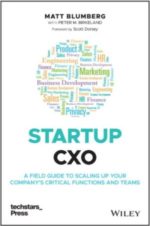My RSS Feed
My RSS Feed
In an effort to manage my blog and RSS feed a little better, I’d like to request that anyone who gets my RSS feed NOT via Feedburner — that is, via the default Typepad feed — resubscribe to the Feedburner feed at http://feeds.feedburner.com/Onlyonce. Thanks!
Counter Cliche: It's Fun at the Top
Counter Cliche: It’s Fun at the Top!
Fred’s VC cliche this week is a good one — that CEOs have the weight of the company on their shoulders, otherwise known as "it’s lonely at the top." He’s right in a lot of ways, and his two suggestions for dealing with it are good. To those, I’d add a third suggestion, which is to create a peer group of other CEOs that gets together periodically to talk, share ideas, and blow off steam. It doesn’t need to be something formal like YPO or YEO — just have a quarterly dinner roundtable with a handful of other local CEOs you know and respect, whether from your industry or not.
But the counter to Fred’s cliche is that while yes, it can be lonely at the top, it can also be a ton of fun. Having the weight of the company on one’s shoulders also means having the ability to do some exciting things:
– Being social and interacting with people all across the organization, at all levels, to really understand what’s going on
– Being multi-disciplinary and working on projects with all departments to make sure things are in sync
– Periodically getting out of the organization and understanding what’s happening in the outside world, with customers, suppliers, partners, and investors
I’m sure there are others, and I’m certainly lucky to have an investor who has sympathy for the "weight of the company" problem — but there are many days where the weight is completely overshadowed by the fun!
A Ball Bearing in the Wheels of E-Commerce
A Ball Bearing in the Wheels of E-Commerce
As an online marketing professional, I’ve long understood intellectually how e-commerce works, how affiliate networks function, and why the internet is such a powerful selling tool. But I got an email the other day that drove this home more directly.
When I started my blog about a year and a half ago, I set myself up as an Amazon affiliate, meaning that any time someone clicks on a link to Amazon from one of my postings or on the blog sidebar, I get paid a roughly 4% commission on anything that person buys on Amazon on that session.
According to the email report I just got from Amazon on Q2 sales driven by my blog, I am responsible for driving traffic that buys about $2,500 worth of merchandise from Amazon every quarter, which yields about $100 to me in affiliate fees. All I really link to are business books that I summarize in postings, although people who click from my blog to Amazon end up buying all sorts of random things (according to my report, last quarter’s purchases included a Kathy Smith workout DVD and a new socket wrench set in addition to lots of copies of Jim Collins’ Built to Last and Malcolm Gladwell’s Blink.
This is a true win-win-win — Amazon gets traffic for a mere 4% of sales, a relatively low marketing cost; I get a small amount of money to cover the various fees associated with my blog (Typepad, Newsgator, Feedburner), and people who read my blog pay what they’re going to pay to Amazon anyway – and maybe get something they otherwise wouldn’t have gone out to get in the process.
My blog is certainly not a top 1,000 blog, or probably not even a top 10,000 blog in terms of size of audience. This is merely a microcosm that proves the macro trends. If I’m driving $10,000 per year of business to Amazon, now I REALLY understand how there are now approximately 500,000 people who make their LIVING by selling goods on eBay, and how probably another 500,000 people are making good side money or possibly even making their living by running offers and affiliate marketing programs from their web sites. I’m like a little ball bearing in the finely tuned but explosively growing wheel of e-commerce.
If my quarterly affiliate fees keep growing, I’ll find something more productive or charitable to do with them than keep them for myself. But for now, I am covering my costs and marveling on a personal level at how all this stuff works as well as it does.
Beyond CAN-SPAM: The Nightmare Continues
Beyond CAN-SPAM: The Nightmare Continues
Turn back the clock to the end of 2003. A bunch of states had recently passed their own anti-spam bills, and California had just passed the then-notorious SB186. Commercial emailers were freaking out because compliance with a patchwork of state laws for email is nearly impossible given the nature of email and given the differences between the laws. The reult of the freakout was an expedited, and decent, though far from perfect, federal law called CAN-SPAM which, among other things, preempted most of the individual state laws under the interstate commerce clause. Most of us noted that the federal government had never worked so swiftly in recent memory.
Now it’s mid-2005, and a new cycle of state email legislation craziness is underway, this time with Michigan and Utah in the lead. Once again, the legislation is well-intentioned but incredibly impractical. I haven’t heard an appropriate amount of kicking and screaming about this yet, so let me give it a shot.
The laws themselves are billed as “Child Protection Acts.” They ban email advertising (and also other electronic forms of advertising, like IM, phone, fax) to minors for things like guns, liquor, gambling, porn, tobacco, and — one of the kickers — “anything else deemed to be harmful to minors or unlawful for minors to purchase.” The bans are in place even if the child has requested the advertising. The proposed solution is an email address registry of chidren’s email addresses which would act as a suppression list for mailers, is run by a third party, and costs a $7 CPM per suppression run, per state, based on the size of the input file, not the size of the matches.
Let me start running down the problems here:
1. The laws won’t work comprehensively, as people have to proactively register their addresses with state registries.
2. The laws won’t do squat to prevent international or fraudulent advertisers from hitting children with their ads.
3. People with multi-purpose “family” email addresses will have to make a black-and-white decision about being on the registry.
4. Compliance will be a nightmare. Since emailers usually don’t have a state tied to an email address, they will have to suppress their entire file against each state’s registry.
5. Charging based on the size of the input file as opposed to the number of matches is ridiculous. It punishes mailers with large files and is completely divorced from the “value” of the service.
6. The costs are outrageous when you add them up. A $7 CPM seems low, but multiply it by 12 months (and some people think compliance means more than monthly suppression runs) and now multiply it by at least 2 states — with another 10 or so considering similar legislation, and all of a sudden, a mailer could be paying as much as $1 per name ON THEIR FILE per year.
7. The laws are too vague and potentially too broad. A law that prevents advertising of anything else deemed to be harmful to minors or unlawful for minors to purchase has some weird and possibly unintended definition consequences. One example: apparently, in Michigan, it is illegal to sell cars to minors (odd for a state that includes Detroit and licenses drivers at age 16) — so automobile advertising is a “banned category.” Another example: Amazon sells DVDs that are Rated R — does that mean linking to Amazon is now problematic?
8. Anyone can sue — not just state AGs, so look out for a zillion nuisance lawsuits like the old Utah “no popup” law of 2003.
9. The laws may be unconstitutional for any number of reasons, and they may also be in conflict with CAN-SPAM’s supersede clause.
The kicker? The laws are billed as “Child Protection Laws” — so who the heck is going to stick out their neck and sue the states to force the legality issue? I’m all for protecting our children…and for eliminating spam for that matter, but I’m sick of governments passing laws with this level of unintended consequences. Someone ought to make a law about that!
Counter Cliche: Win The Peace
Counter Cliche: Win The Peace
Fred’s VC cliche of the week this week is a good one, Hope for the Best and Prepare for the Worst. It’s certainly true, as he says, for startups going through a financing, and in many other instances. I may regret mixing business and politics here, but since Fred has done that before (with the same caveat), I’ll give it a shot as well.
As important as it is to prepare for the worst, entrepreneurs and politicians alike need to make sure they’re also planning to win the peace — in other words, planning for a successful outcome.
How much happier would we be as a country at war right now if our administration had had a full plan in place for what to do after they toppled Saddam? Similarly, CEOs need put some cycles against scenario planning for successful outcomes so they’re not caught flat footed when things go well. How can lack of planning to win the peace come back to bite you? Here are a few ways:
– You’re not staffed properly to support a big contract that comes in — and you have no pipeline of candidates or contractors to backfill
– You don’t have media buys lined up for an marketing campaign you want to run as soon as the financing closes
– You haven’t started an integration plan before a tenuous acquisition closes, so integration doesn’t happen quickly enough
There are certainly other examples as well, in war as in comapny-building, but what it all comes down to is the need to scenario plan for best cases as well as worst cases. It’s all about avoiding costly lead times.
Book Short: Why Not Both?
Book Short: Why Not Both?
Craig Hickman’s Mind of a Manager, Soul of a Leader talks about how tapping the natural tension between managers and leaders allows an organization to achieve its best. It covers dozens of topical areas and for each compares how a prototypical manager handles the area (practical, reasonable, decisive) vs. how a prototypical leader handles it (visionary, empathetic, and flexible). Of course, the book describes the ideal organization as “balanced an integrated” between the two extremes.
My take for startups, a topic not addressed in the book, is that the job of the entrepreneur CEO is to be both manager and leader, and try to do both roles effectively without driving the team nuts. The book says that “managers wield authority, leaders apply influence.” Entrepreneurs have to be comfortable with both styles. Thanks to my colleague Stephanie Miller for giving me a copy of this one.
Highs and Lows
Highs and Lows
I was reminded recently of one of my favorite entrepreneur sayings. What drives me nuts isn’t the inevitable presence of highs and lows of running a new company, it’s when they happen at the same time.
It’s one thing to get used to the roller coaster ride of running a startup. That’s part of the fun and the challenge of it all. There are great moments when everything’s working beautifully. Your strategy is proving to be spot-on. Your team is executing brilliantly. Your biggest client renews and gives you a testimonial. Then there are the dark moments of despair. You’re running out of cash. The new product release is behind schedule. A competitor steals a top client. No one lives for the lows, but you at least grow to anticipate them and realize that "this, too, shall pass."
But the thing I can never get used to is when those highs and lows occur simultaneously. It just seems unfair. Let me enjoy the good news — whatever it is — for at least a day or two before clocking me with something terrible! But perhaps that’s just another, even more poignant part of the humbling process that comes with running a startup.
New Del.icio.us for: Tag
Book short: Blink
Book short: Blink
Blink, by Malcolm Gladwell, is a must read for marketers, entrepreneurs, and VCs alike, just as is the case with Gladwell’s first book, The Tipping Point.
Where The Tipping Point theorizes about how humans relate to each other and how fads start and flourish in our society, Blink theorizes about how humans make decisions and about the interplay between the subconscious, learned expertise, and real-time inputs. But Gladwell does more than theorize — he has plenty of real world examples which seem quite plausible, and he peppers the book with evidence from some (though hardly a complete coverage of relevant) scientific and quasi-scientific studies.
Blink for Entrepreneurs/CEOs: What’s the most critical lesson in Malcolm Gladwell’s Blink, as it relates to entrepreneurs/CEOs? It’s about bias in hiring. Most of us make judgments about potential new hires quite quickly in the initial interview. The symphony example in the book is the most painfully poignant — most major symphony orchestras hired extremely few women until they started conducting auditions behind a screen. It’s not clear to me yet how to stop or even shrink hiring bias, but I suspect the answer lies in pre-interview work around defining specific criteria for the job and scoring all candidates on the same set of criteria.
Blink for VCs: What’s the most critical lesson in Malcolm Gladwell’s Blink, as it relates to VCs? It’s about picking companies to back. Even VCs who are virtuosos, as Gladwell would call them, can make poor judgments on companies to back based on their own personal reaction to a company’s product or service, as opposed to the broader marketplace’s reaction. Someone poured a whole lot of money into Webvan, Pets.com, eToys, and the like.
Blink for Marketers: What’s the most critical lesson in Malcolm Gladwell’s Blink, as it relates to Marketers? It’s the importance of multivariate regression testing. No, really, I’m not kidding, although there’s no doubt a less math-y way of saying it — “test everything.” The Coca-Cola Company thought they were doing the right thing in creating New Coke because they were losing the Pepsi Challenge. But what they didn’t realize was that Pepsi (unintentionally or not) had suckered them into believing that the single-sip test was cause for reengineering a century of product, when in reality Coke was probably just being out-advertised. Christian Brothers Brandy was going out of its mind losing market share to competitor E&J until someone realized that they just needed to change the shape of their bottle.
If you haven’t yet done so, go buy the book! It’s a very quick read and incredibly thought provoking. And if you haven’t yet read The Tipping Point, it’s a must as well.
Book Short: Legal Aid
Book Short: Legal Aid
The Entrepreneur’s Guide to Business Law, by Constance Bagley (HBS) and Craig Dauchy (Cooley Godward), while not exactly a page-turner, is a great reference book for even experienced CEOs. It’s pretty broad in its coverage of all major legal issues an entrepreneur will face, from patent law to firing employees.
Remember, you may make fun of lawyers on occasion or grips about their fees, but they DID attend law school for three years, after all. If nothing else, the $20 on this book will almost certainly save you at least 10x that in reduced legal fees someday, for something.
A Lighter, Yet Darker, Note
A Lighter, Yet Darker, Note
I’ve been meaning to post about this for some time now since my colleague Tami Forman introduced me to this company. It’s a riot.
You know all those well-intentioned, but slightly cheesy motivational posters you see in places like dentists’ offices? The kind that talk about “Perseverence” and “Commitment” and “Dare to Dream” and have some beautiful or unique, usually nature-centric image to go with them and their tag line?
For the sarcastic among us, you must visit Despair, Inc.’s web site, in particular any of the “Individual Designs” sections featured on the left side navigation. The posters are brilliant spoofs on the above, with such gems as “Agony” and “Strife” and “Despair” (whose tag line is “It’s always darkest just before it goes pitch black”). E.L. Kersten is one funny, albeit strange dude.
Worth a look, and everything is for sale there, too, in case you need to have these posted in a back room somewhere.



